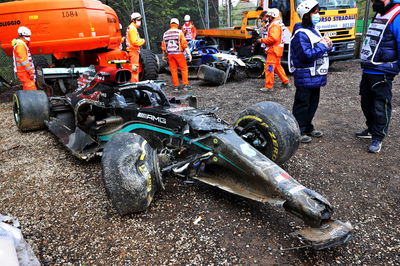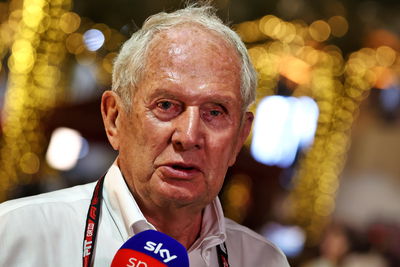Why Bottas ended miserable Imola F1 weekend defending from a Williams
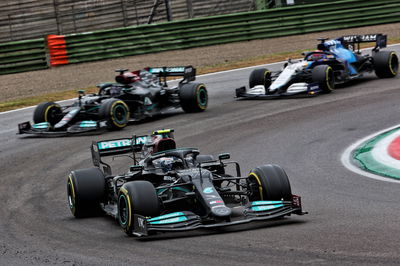
Even before his race-ending shunt, Valtteri Bottas was already having one of the worst weekends of his Mercedes Formula 1 career at Imola.
Much of the post-race focus centred around his spectacular coming together with Williams driver George Russell that caused both drivers to violently crash out of the race at half-distance as they battled for ninth place.
While the potential ramifications of the incident and argument over who was at fault for the collision were the focal point of attention in the aftermath, an equally important question lingered.
Why was Bottas in such a lowly position and fighting a Williams in the first place?
“The whole situation should have never happened,” Mercedes boss Toto Wolff summarised after the race. “Valtteri had a bad first 30 laps and shouldn’t have been there.”
Indeed, Bottas had endured an awful start to what turned out to be a miserable Emilia Romagna Grand Prix at a venue he had taken pole at just five months earlier.
Having immediately dropped two places and fallen to 10th, Bottas made very little progress in the opening stint and looked to be heading further backwards at the time of his crash with Russell.
The incident occurred shortly after he had just been lapped by race leader Max Verstappen and overtaken by Lance Stroll’s Aston Martin for eighth.
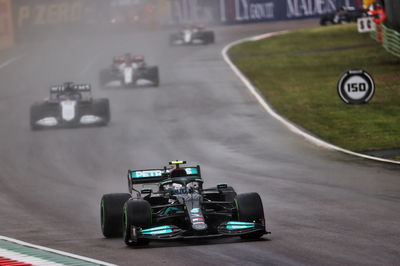
Mercedes teammate Lewis Hamilton was also set to put a lap between himself and Bottas before he was caught out by damp conditions and slid off the track at Tosa.
If anything, getting wiped out by Russell spared Bottas’ blushes of facing more potential embarrassment on what was fast turning into a forgettable afternoon.
Bottas admitted after the race that his performance across the weekend was nowhere near the level he expects from himself and stressed “the main thing we need to focus on is why I was in that position.”
Tyre warm-up ultimately proved to be Bottas’ Achilles’ Heel at Imola. Despite making what appeared to be a positive start as he topped the timesheets in both practice sessions held on Friday, his weekend quickly unravelled.
This was largely down to the fact that Bottas struggled to switch the Soft tyres on during cooler conditions in qualifying. He was unable to match the leading pace of Hamilton and the Red Bulls and that resulted in him coming under threat from improving midfield runners in Q3.
Not only did Bottas fail to factor in the pole shootout, but he went on to end up a lowly eighth on the grid - behind Charles Leclerc’s Ferrari, AlphaTauri’s Pierre Gasly and the McLaren duo. Bottas’ Q3 time ended up being slower than what he managed in Q1, which came after several attempts on the Soft tyres but would have been good enough for P4.
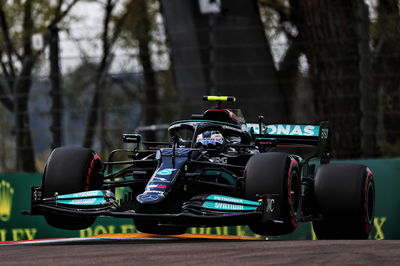
“I think it’s a bit overall thing with our car,” Bottas explained. “Over the years, we quite often struggle in hot conditions, and cold has been normally good because we’ve had good tyre warm-up.
"We’ve been really trying to develop the car, but didn’t overheat the tyres, but obviously with the negative that if we need to get quickly into the tyres, then maybe some other cars can do it better than us.
“For me personally, for example, compared to Lewis, it’s so on a knife-edge in qualifying, that sometimes you get it to work, like for me in Q1, when I did a much faster time than in Q3, I got them to work.
“But for some reason, I couldn’t get them to work in Q3 the same way. It's all about one or two degrees of surface or tyre temperature. It’s hard to explain. Obviously, track temp was changing a bit, depending how much cloud there was etc, so maybe that had a bit of a factor.”
A downpour of rain less than an hour before the race start only exacerbated Bottas’ warm-up issues further by creating even trickier conditions and leading to the majority of the field starting on Intermediate tyres.
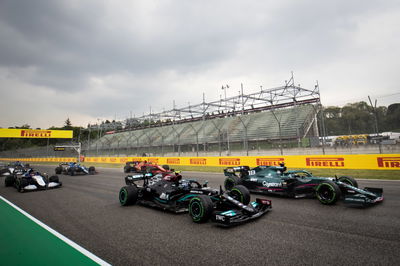
Bottas also struggled in similar conditions during last year’s Turkish Grand Prix, with the Finn spinning no fewer than six times on his way to finishing 14th and being lapped by race-winner Hamilton.
“Obviously I had quite a struggle with the inters, being stuck behind Lance all through the inter section of the race, and when I stopped, obviously got pressure from the guys behind who stopped earlier and got their tyres working already,” Bottas added. “That warm-up was the bigger issue.”
It is an issue that Mercedes is looking to get to the bottom of ahead of the Portuguese Grand Prix.
“There’s something there we need to understand,” said Mercedes’ trackside engineering director Andrew Shovlin. “The thing with tyre temperature is often a very small difference has a very big impact on the grip.
“Unfortunately for Valtteri [in qualifying] he was just the wrong side of a lot of cars and that gave him a compromised start position. So that’s one thing we’ll need to go off with him and help him understand.
“In the race, he was struggling following and being able to overtake just because he was losing front end in the tow but also the rear wasn’t strong. Again, it was that theme of warm-up was a problem for him.
“Then on the transition to Mediums the warm-up meant that he got caught in that bunch of cars - Max was there as the leader coming through, and that was what really triggered the sequence that ended his race.
“There have been bits of the weekends where he has definitely looked very strong and parts where he actually looked like he’d give Lewis a tough time, and really I think all the negatives have come down to this issue of warm-up in those conditions and we need to find a solution to do that. I think if we do that the rest of it should click into place.”
The result is that after just two races, Bottas already finds himself facing a 28-point deficit to Hamilton and risks being completely cut adrift in the title race unless something changes fast.
